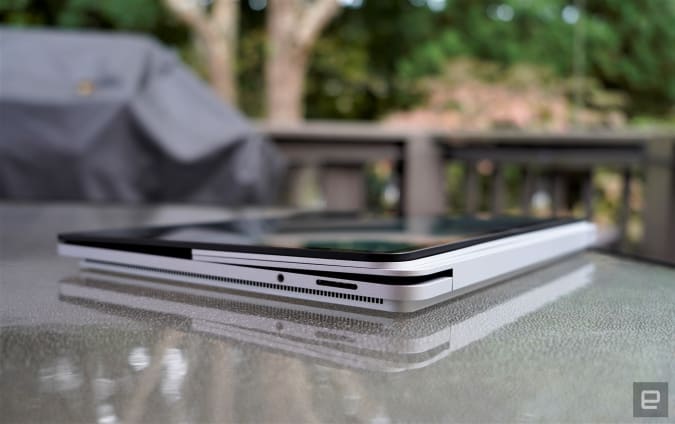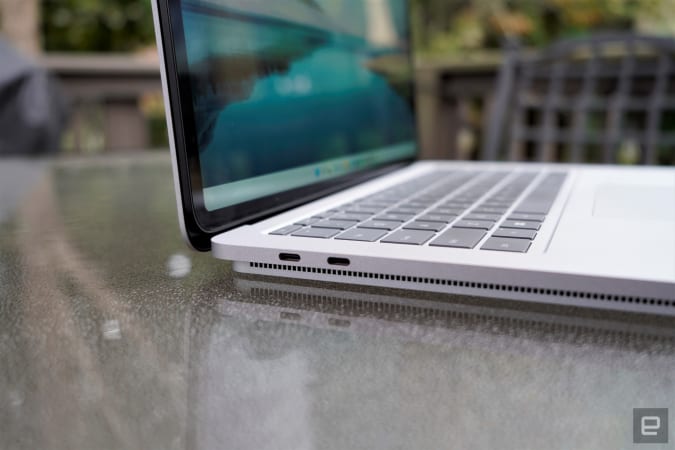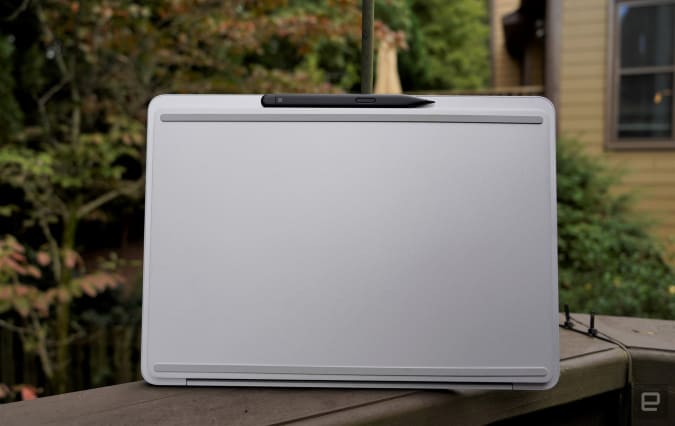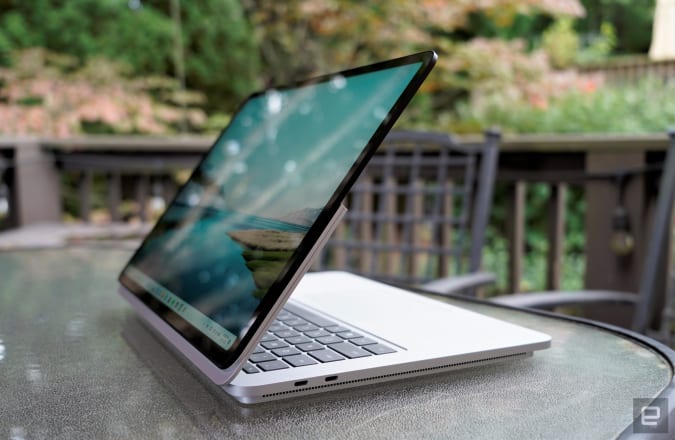Surface Laptop Studio review: A better Surface Book, a missed opportunity
Image Credit: Devindra Hardawar/Engadget
Even though it’s surrounded by some chunky bezels — something Microsoft avoided with the Surface Pro 8 — the Laptop Studio’s display entranced me. And that’s before I started spending time with its flexible modes. You can pull it forward with just two fingers, and it magnetically rests between the keyboard and trackpad. That’s useful for binging video, especially if you prefer using the touchpad instead of dirtying your screen. Another plus for the Surface Studio: It has surprisingly powerful speakers, including two subwoofers spitting sound out the sides of the laptop, and two tweeters blasting through the keyboard. They also support Dolby Atmos for (very basic) simulated surround sound.
You can get into easel mode by pulling the Laptop Studio’s screen completely forward, where it’s angled up slightly for sketching and writing. And while Microsoft hasn’t advertised this too much, you can also push the screen backwards so that the keyboard is completely behind it. That could be helpful for stepping through presentations without turning your entire computer around.
Devindra Hardawar/Engadget
That last orientation also gives you a clear view of the Surface Laptop Studio’s unique hinge. The area directly underneath the display is covered in a smooth cloth, which also keeps the hinge from making direct contact with the screen. The hinge mechanism feels a bit flimsy at first, until you figure out where the display is supposed to rest for each mode. Microsoft reps tell us that they typically put their hinges through years of testing, so they should last for the lifetime of the laptop. Still, I’d certainly be anxious about putting this laptop in front of a small child. My parental spidey sense can foresee disaster if a kid starts pulling the screen.
A solid Surface Book successor… mostly
The big takeaway after living with the Laptop Studio for around a week: It’s so much easier to use than the Surface Book. I don’t have to worry about hitting the eject button to release the screen, and placing it in the exact right spot when I want to lock it back in. There’s no obscene hinge curve, which always made it difficult to fit the Surface Book into slim bags. And finally, Microsoft can throw more power into a high-end Surface!

Devindra Hardawar/Engadget
Well, sort of. The Laptop Studio is powered by quad-core 11th-gen Intel chips, either the i5-11300H or the i7-11370H. Both are a big step up from the 10th-gen hardware in the Book 3, but it’s curious that Microsoft didn’t push for six or eight-core CPUs. If Dell can squeeze a six-core chip into the XPS 13, why can’t Microsoft make that happen in its flagship Surface notebook? When asked about the power limitation, Microsoft representatives said their research showed a quad-core CPU with discrete graphics (the Laptop Studio can also be equipped with NVIDIA’s RTX 3050 Ti) was the best option for their users. But as someone who knows plenty of media professionals and other would-be Laptop Studio customers, I find that hard to believe.
Even if that’s the case, it’s hard to recommend a system with a quad-core chip when there are so many competitors sporting more power. At least Microsoft is using Intel’s beefier H35 chips, which are meant for ultraportable gaming laptops. Our benchmarks show the Laptop Studio is a significant step up from the Book 3 in every benchmark. But it doesn’t have a chance against the Razer Blade 14, which can be equipped with an eight-core AMD CPU and NVIDIA RTX 3080 GPU. That’s particularly damning when the Blade 14 tops out at $2,800, whereas the comparable Laptop Studio model is $2,700. The only downside for Razer is that its machine comes with 16GB of RAM, instead of the Surface’s 32GB.
|
PCMark 10 |
Geekbench 5 |
3DMark Night Raid |
ATTO disk speeds (top read/write) |
|
|
Surface Laptop Studio (Intel Core i7-11350H, NVIDIA RTX 3050 Ti) |
5,397 |
1,445/5,430 |
26,566 |
3.2 GB/s / 3 GB/s |
|
Razer Blade 14 (AMD Ryzen 9 5900HX, NVIDIA RTX 3080) |
6,551 |
1,443/7,226 |
35,812 |
3 GB/s / 2GB/s |
|
Surface Pro 8 (Intel Core i7-1185G7, Xe graphics) |
4,542 |
1,289/5,217 |
16,092 |
2.25 GB/s / 1.47 GB/s |
|
Surface Laptop 4 15″ (AMD Ryzen 7 4980U Surface Edition, Radeon) |
4,620 |
1,048/6,551 |
15,517 |
1.9 GB/s / 985 MB/s |
It could just be that Microsoft is setting itself up for an even bigger Laptop Studio down the line. The Book 3 came in 13.5- and 15-inch variations, so I wouldn’t be surprised to see a future 16-inch studio with even beefier hardware eventually. Perhaps Microsoft is just waiting to see what Apple’s next hardware refresh means for the 16-inch MacBook Pro.
Ignoring how it competes on a hardware level, the Laptop Studio is a solid performer for everyday computing tasks. It’s also fast enough to reach between 90 and 100fps in Overwatch at the Studio’s native resolution and ultra graphics settings. That’s better than what I saw with the XPS 15 OLED, which could only reach around 70fps in 1,440p with a slightly slower RTX 3050 Ti. For most people, it’ll be very capable for media work with some light gaming on the side. Still, I can’t help but sigh at some of the benchmarks: how is it only slightly faster than the Surface Pro 8 — a tablet — in Geekbench 5?

Devindra Hardawar/Engadget
I was similarly annoyed by the Surface Laptop Studio’s anemic port situation. It only has two USB-C ports alongside the proprietary Surface Connect slot. Thankfully, those USB-C connections also support ThunderBolt 4, so they’ll work with high-bandwidth storage devices, external GPUs and let you string together multiple 4K external monitors. Still, it’s a shame to see the Book 3’s SD card slot go. I suppose Microsoft is just following in Apple’s footsteps here with the 13-inch MacBook Pro, but it sure seems like a missed opportunity to outdo their competitor. Also, strangely, while the Surface Pro 8 has an easily accessible NVMe SSD slot for additional storage, there’s no secondary SSD slot for the Studio. (Though you could unscrew the bottom of its case and replace its SSD eventually.)
So that’s a few big strikes against the Surface Laptop Studio, at least as a machine meant for creative professionals. Thankfully, Microsoft brought over one of the best aspects of the Book 3: that fabulous keyboard. It’s wide, responsive and has some of the most satisfying key travel I’ve ever felt in a laptop. It’s also accompanied by a Precision Haptic touchpad, which has no moving parts, but does a great job of mimicking that click you feel when pressing on a trackpad. That tech isn’t new, exactly: Apple has offered it on MacBooks since 2015, but we’re only now beginning to see it on PCs, like Lenovo’s ThinkPad X1 Titanium Yoga.

Devindra Hardawar/Engadget
The new Surface Slim Pen 2 — which unfortunately costs an additional $130 — is also the perfect companion to the Laptop Studio’s excellent keyboard and trackpad. It’s easy to hold and it has a haptic motor of its own, which helps to mimic the feeling of putting pen to paper. That’s a thoughtful addition, as the feeling of a stylus nub against glass always felt unnatural to me. The Slim Pen 2, meanwhile, makes me feel like I’m actually writing in a notebook. And unlike the Surface Book, there’s a secure spot to store the new stylus right underneath the keyboard. It also wirelessly charges off of the Surface, which is much more convenient than carrying around tiny spare batteries.
Speaking of batteries, the Laptop Studio lasted an admirable 12 hours and 25 minutes with a 120Hz refresh rate during our battery benchmark. When I knocked that down to 60Hz, a must if you ever need to save some energy, it went for 17 hours and 15 minutes. But really, save your eyes whenever possible — just keep 120Hz on.

Devindra Hardawar/Engadget
Wrap-up
Here’s the thing: I genuinely like using the Surface Laptop Studio. Its flexible screen is far less frustrating than the Surface Book’s, it has an excellent keyboard and it’s powerful enough to play a few games. But I can’t help but want more, especially after seeing how much the Surface Book line struggled since its inception.
With a starting price of $1,600, the Surface Laptop Studio directly competes with Dell’s XPS 15, the MacBook Pro 16-inch, and the Razer Blade. You’d have to shell out at least $2,100 to get the NVIDIA GPU, which puts it up against far more powerful gaming laptops. So here’s the question: How much is a tilting screen worth to you? If it’s more important than having the best CPU and GPU power around, the Surface Laptop Studio will suit you well. But if you want genuine power for a similar price, just get the Razer Blade 14 already.
All products recommended by Engadget are selected by our editorial team, independent of our parent company. Some of our stories include affiliate links. If you buy something through one of these links, we may earn an affiliate commission.
For all the latest Technology News Click Here
For the latest news and updates, follow us on Google News.
